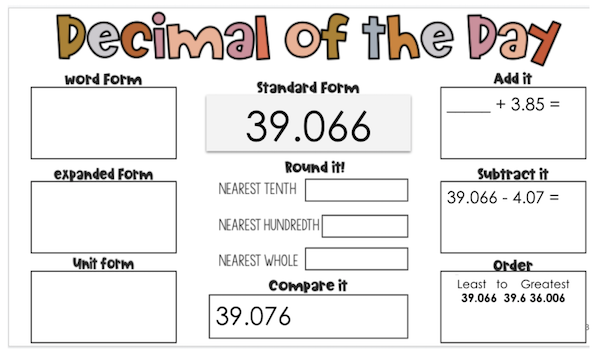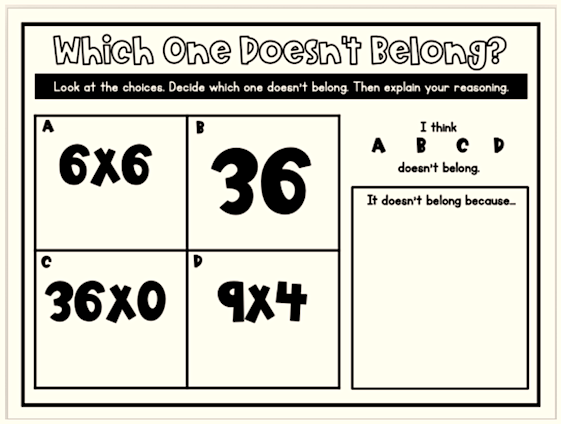Spark Math Engagement with Daily Warm-Ups

By Mona Iehl
Now more than ever, keeping students engaged in math class is top priority. I attempt to start my math class in ways that engage my students with mathematical thinking.
Math warm-ups help me launch my 5th and 6th grade students into meaningful math work without all the chaos that the start of class can sometimes bring. Math warm-ups are part of my entrance routine, enticing my students to get started quickly, engage in math thinking, and practice priority skills.
What Makes a Math Warm-Up Engaging?
A math warm-up that feels attainable and relevant is engaging. Choosing a math warm-up that is open-ended allows students to practice math concepts and gain valuable experiences practicing the Standards of Mathematical Practice. Open-ended tasks often ask students to provide evidence to justify their answers and reasoning.
These types of tasks naturally differentiate because they allow all learners an entry point into the task, while also providing opportunities for students to extend to higher level thinking. Open ended math warm-ups help our students feel engaged by allowing them space to solve and discuss their math thinking.
The math skills that are being practiced in math warm-ups should be simple enough to fit into 10-15 minutes. If my students are practicing a bigger concept, I break down it down into something more simple for the warm-up.
In this instance, I like to use warm-ups to review misconceptions or common mistakes. For example, when my students are working on multiplying and dividing fractions our warm-up might address equivalent fractions or common denominators.
Four Things to Remember about Warm-Ups
#1 Routine
By creating a structure that your class knows well and can execute independently, you create a routine. A math warm-up routine allows your student independence and responsibility in the classroom. I spend a small amount of time each day reminding, reviewing, and explaining how to engage appropriately. It is well worth the time to remind students and make the expectations clear.
When students know what is expected of them, they are more likely to jump in and participate. The routine empowers students to take the lead in completing their work without help from the teacher, and in turn frees up the teacher’s time to differentiate and support students with just-in-time scaffolding.
For more ideas on establishing a math classroom community in middle grades, check out this blog post: 4 Moves to Help Tweens Overcome Math Anxiety
#2 Support Independent Grappling
Build students’ capacity to work independently on tasks. Talk with students about what it means to grapple and why it is important to the learning process. Remind students that this is a time to make mistakes and learn from them, truly living out all those growth mindset quotes!
#3 The Right Format
Open math tasks come in all shapes and sizes. Number of the Day is a crowd favorite in my math classroom because it allows students to practice several skills in a predictable format while still giving the flexibility to solve the problems with their own strategies and models. Here’s a decimal version:

Which One Doesn’t Belong is another engaging math warm-up because there is truly no right answer. Instead, a case can be made that any option does or doesn’t belong. Another reason Which One Doesn’t Belong works well as a math warm-up is because of its versatility. You can create a Which One Doesn’t Belong to match nearly any concept. In fact, this website has several hundred pre-made, free WODB’s.


#4 Predictable Lesson Structure
I use the same lesson structure each day to start my middle school math class. Students are asked to engage in independent work and discussions in this short warm-up. I find that discussing the math warm-up engages students in collaborative listening, discussion, and problem solving.
► First, as students grapple independently, I monitor students’ solving. This is my time to observe students’ thinking. I watch them solve, ask probing questions, and provide the support they need. During this time I make note of misconceptions, exemplar models, and opportunities for a nudge.
► Next I select students to share, and I sequence their sharing in a way that will allow their shares to drive our discussion toward deeper math understanding. This helps me efficiently address the common misconceptions or gaps in understanding with the whole class.
► Then we have a quick student-led discussion. Students react to those students who shared their reasoning while also adding their own. This is particularly lively in the WODB activities. The discussion builds students’ ability to make a claim, justify their response, and support their answers with evidence.
► Finally, we reflect. “How has your thinking changed based on what you heard from your peers?” “Maybe it hasn’t changed? How come?” In the case of WODBs I will ask, “Are you looking at the 4 choices differently now?”
I give students prompts to consider. Sometimes we respond to a prompt by jotting it down or sharing it with an elbow partner. Either way, the reflection is an essential step in synthesizing their thinking before we move on to the lesson.
Give Your Warm-Ups a Chance to Work
If you’re looking for a way to engage your students in deep mathematical thinking as soon as they walk into your math classroom, give math warm-ups a try. Choose one and stick with it for a few weeks.
Remember that anything worth it takes time to develop. Be sure to spend some time teaching the routine and practicing participating in the math warm-up. I can’t wait to hear how your students’ brains start to grow in those first few minutes of math class.
You can see an example of my warm-up in action in a video made during my virtual classroom in 2020. It’s on this MiddleWeb post at minute 3:39.
Mona Iehl is an elementary and middle grades educator who transformed her approach to teaching math by embracing student-centered methods that foster curiosity and engagement. She has captured her process in her new book, Word Problem Workshop: 5 Steps to Creating a Classroom of Problem Solvers (Routledge/Stenhouse, Fall 2025), available for pre-order. Mona now coaches educators to create inclusive math classrooms where all students develop deep, lasting problem-solving skills. Follow her Math Chat Podcast and connect with her online @HelloMonaMath and at Bluesky. [Updated April 2025]





























